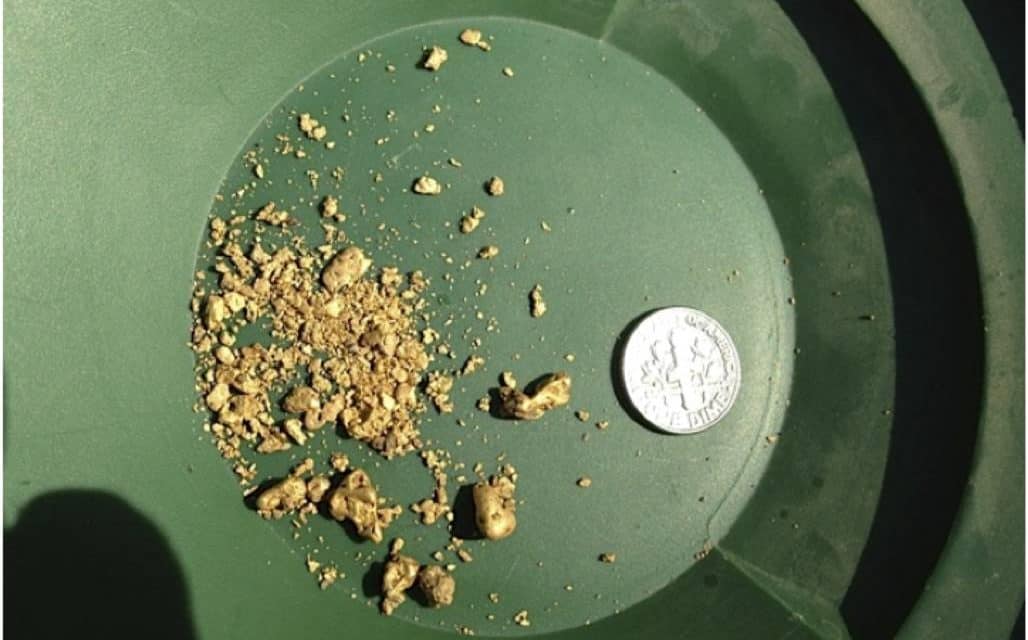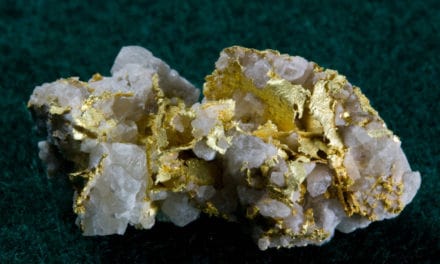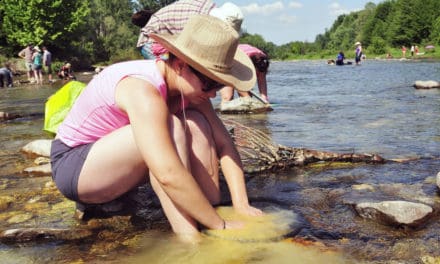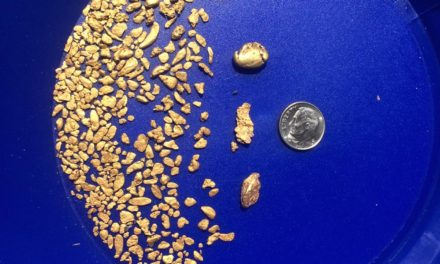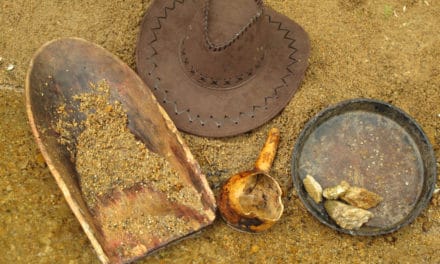Six pounds of gold from an unknown location in Plumas County, California.
Tertiary Placer Gold!!
Courtesy of Charles P. Watson
[media-credit name=”bigstockphotot” align=”alignleft” width=”300″] [/media-credit]
[/media-credit]
It had been raining for two weeks straight. The streams were full and the mud was thick and sticky. The saloon doors quickly swung open and the man wearing a long leather coat dripping of rainwater turned and used the mud chucker to scrape the mud from his boots. He slowly sauntered up to the bar, his hat shading his eyes, never making eye contact with anyone.
As he pulled open his coat, the bartender instinctively reached for his shotgun. The man dug into his pocket and pulled out an obviously heavy leather pouch, and slammed it on the bar. “Whiskey!” he shouted. “All around! Drinks on me!” Cheers went up from all around the bar, and then there was silence as the man poured several ounces of gold into an empty beer mug that was left on the bar. The man had just made lots of friends.
Prospecting in the early 1850s was initially crude, consisting of picks, shovels and pans. The rocker box was a lame contraption that lost more gold than it recovered. But in 1851, the long tom or sluice box was pioneered and miners reworked the tailings left behind by the “rocker boxers,” a quaint nickname for these early day miners.
As creeks dried up in the late summer months, miners would divert water from other streams to sustain the flow to their own creek.
One fateful day in the summer of 1851, miners working the stream saw one of these diversion ditches breached, sending a cascade of water down slope. After repairing the opening, miners found nuggets in the gullies caused by the sudden erosion. They noticed the water had cut down into high bench gravels that were also rich in gold.
As placer miners left the streams and worked the bench gravels higher and higher on to the surrounding ridges, they noticed massive, thick gravel deposits on the top. The creeks eroding from these deposits were full of gold, suggesting these ridge-top gravels were the source of the gold. Miners throughout the Sierra left the streams and began mining the ridge gravels instead. Since then, several geologists have studied these auriferous gravel deposits trying to figure out their age, their distribution and where the source of the gold was.
In the 1911 landmark U.S. Geological Survey publication, “The Tertiary Gravels of the Sierra Nevada of California,” Waldemar Lindgren inferred that these deposits were part of ancient river systems that existed millions of years ago and long before the Sierra Nevada had risen into the prominent mountain range they are today. Their age was later determined to be 30-40 million years, depending on the channel and its location.
Lindgren visited numerous Tertiary placer mines, interviewed hundreds of miners, studied the deposit’s geology and cataloged the mine’s productivity. Some channels traveled south to north, others southeast to northwest. Most rivers in the Sierra now travel east to west to the Sacramento and San Joaquin Valleys. Some of the old channels were incredibly rich and produced ounces of gold per cubic yard. Others contained only traces of fine gold and were the demise of many unsuspecting early prospectors.
Lindgren thought that the gold was from rich local sources found in the Sierra Motherlode. However, recent work suggests that most of the gold likely came from ancient highlands in Nevada, now buried by thick layers of volcanic rock. Clearly, however, California’s Motherlode sources played a large role in enriching these old river systems, such as the Ruby Mine in Sierra County.
In the Preface to the 1978 reprint of Lindgren’s publication, Jack Black writes “Why a reprint of The Tertiary Gravels of the Sierra Nevada of California? It is a labor of love partly, but more than this book is, I feel [it is] the most important single work ever published that tells, “where the gold is.” For any professional, or well knowledged amateur gold prospector knows that there remains more gold in California’s Sierra Nevada than has ever been dug out.”
The new pioneer miner of today will soon learn that it was these Tertiary river channels that were the source of much of the gold that was deposited into the current rivers and streams in the first place. Find a Tertiary gravel deposit up stream and the down stream reaches will have gold.
Most of the Tertiary gravel deposits were mined with hydraulic water cannons or monitors that would simple melt the gravels away and into sluice channels where the gold would be recovered. At the time, it was considered a mining revolution, but all that gravel went into the active drainages and literally buried anything down stream. In 1886, hydraulic mining was banned, but in 1892 it was reestablished as long as the miner could keep the sediment on their property. Some operations resumed but most were abandoned and the infrastructures scavenged.
There are numerous auriferous Tertiary gravel deposits that still remain in California, most in some state of abandonment and only partially mined out. With modern day excavating equipment, better gold recovery techniques, and the price of gold hovering around $1,300 per ounce, mining these Tertiary deposits now may prove to be a win-win-win opportunity. It would be good for the environment as it reclaims these exposed lands and stops a point source for sediment, good for the county because they get an oversight revenue source for the mining operation, and good for the miner because he gets the gold. All the reclamation would be paid for with the gold that still remains in these deposits.
Gold mining is not a new endeavor. It is something within our blood — something that we feel is right. Today’s miners are smarter than every before. They have better tools to recover the precious metal and the wisdom to work with Mother Nature. Today’s miners are responsible citizens and reclamation is part of their mining process.
It is a thrill to find your first gold speck, flake or nugget. Once you do, you will be hooked forever. It is fun for the whole family and who knows, maybe, just maybe, if you are a wee bit lucky… you too will jump for joy, click your heels, and shout “Eureka! I found it!”
Charles P. Watson is the chief geologist at Advanced Geologic Exploration, Inc. located in Chester, California. He can be reached at cwatson@advancedgeologic.com or at www.advancedgeologic.com.
Advanced Geologic is a purveyor of high quality gold mining claims. They also provide superior mining and geologic advice, and can assist you with all your permitting needs. The gold rush is on! Contact them and claim your fortune!

